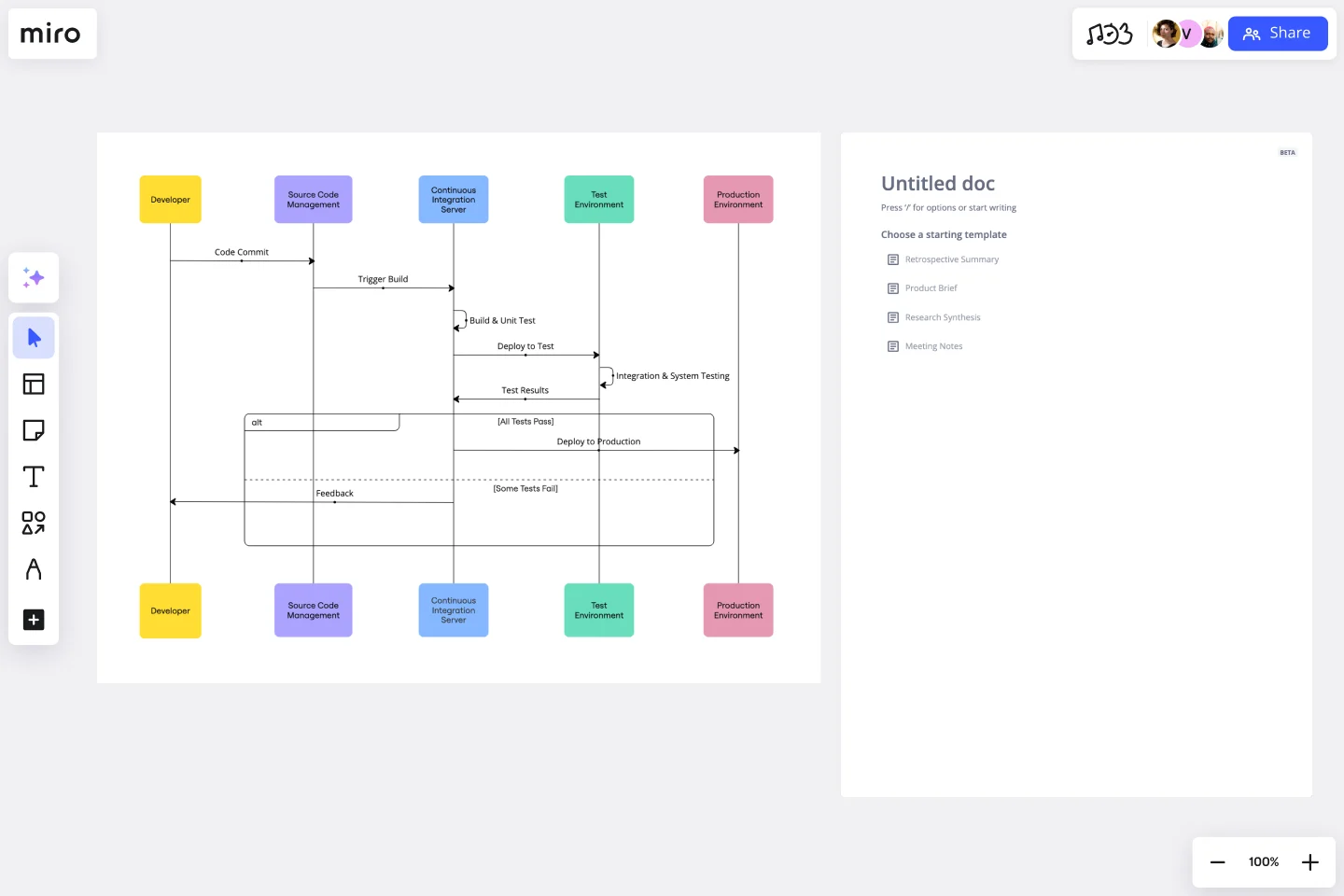UML Sequence Deployment Pipeline Template
Reduce the risk of deployment failures and support the standardization of deployment processes across projects or teams with the UML Sequence Deployment Pipeline Template.
Available on Enterprise, Business, Education plans.
About the UML Sequence Deployment Pipeline Template
The UML Sequence Deployment Pipeline Template is a tool designed to visualize the sequence of steps in an automated deployment pipeline. This template helps illustrate the flow from code commit through the build, test, and deploy stages. It serves as a visual representation, making it easier to understand the interactions and processes involved in deploying software. By mapping out these steps, teams can ensure a smooth and efficient workflow, identifying potential bottlenecks or issues in the deployment process.
How to use the UML Sequence Deployment Pipeline Template
Edit the template: Once the template is on your board, you can customize it according to your project's needs. You can modify the template using UML shapes and features or even create a diagram from scratch.
Collaboration: Invite team members to collaborate on the diagram by sharing the board with them. Team members can provide real-time feedback, make edits, and contribute to the deployment pipeline planning.
Integration and automation: Use Miro's integration features, such as Miro AI or text-to-diagram apps like PlantUML and Mermaid, to automate parts of the diagram creation or enhance the template with additional data.
Why use the UML Sequence Deployment Pipeline Template
The UML Sequence Deployment Pipeline Template is an invaluable resource for teams involved in software development and deployment. Here are several reasons to use this template:
Clarity and understanding: It provides a clear and detailed visual representation of the deployment process, making it easier for team members to understand the sequence of actions and their roles.
Efficiency: By visualizing the deployment pipeline, teams can identify and address inefficiencies or bottlenecks, streamlining the deployment process.
Collaboration: The template fosters collaboration among team members, allowing for a shared understanding and collective input on the deployment strategy.
Risk reduction: The template helps in reducing the risk of deployment failures by allowing teams to preemptively identify and mitigate potential issues in the deployment process.
Documentation and standardization: It serves as a form of documentation that can be used to standardize the deployment process across different projects or teams within an organization.
Training and onboarding: The template acts as a valuable educational tool for new team members, providing a clear overview of the deployment process and facilitating quicker onboarding.
Continuous improvement: By visualizing the deployment pipeline, teams can continuously identify areas for improvement, leading to more efficient and reliable deployments over time.
Get started with this template right now. Available on Enterprise, Business, Education plans.
UML Class Content Management System (CMS) Template
Works best for:
UML
The UML Class Content Management System CMS Template simplifies documenting and designing the architecture of a Content Management System. It allows for the creation of UML class diagrams to visualize the structure of a CMS. Teams can efficiently map out key classes and their interactions, such as how users create, manage, and publish digital content. The template's integration into Miro's collaborative platform allows for real-time teamwork, customization, and easy sharing of feedback. This streamlines the documentation process and is valuable for software development projects aiming to develop or refine a CMS.
Web Diagram Template
Miro's Web Diagram Template simplifies complex project organization and promotes effective communication. It allows users to easily connect elements and gain a comprehensive understanding of complex relationships, making it a versatile and invaluable asset for diverse projects.
ERD Blogging System Template
Works best for:
ERD
The ERD Blogging System template in Miro efficiently manages and organizes digital content. It features key entities such as User, Post, Comment, Category, Tag, and File, which are essential for managing the creation and publication of blog posts, engaging users through comments, and organizing content via categories and tags. Additionally, it supports media attachments through the File entity, linking them to the relevant content. This template helps streamline the blogging process, making it an invaluable tool for content management and publication.
Gantt Chart Project
Works best for:
Strategy, Planning
The Gantt Chart Project template is a versatile tool for managing various types of projects. It provides a clear visual timeline of your project's tasks, deadlines, and dependencies. Use it to plan, execute, and monitor your project's progress, ensuring all activities are aligned and on track. This template enhances team collaboration, improves time management, and helps address potential bottlenecks for successful outcomes.
Define Your Product's Target Audience
Works best for:
Product Management, Planning
Too broad an audience? Or trying to target too many audiences? This is a certain path to product failure.
The Tiered Pricing Canvas - Product Plans
Works best for:
Product Management, Planning
The Tiered Pricing Canvas - Product Plans template helps product managers design tiered pricing strategies effectively. By mapping out pricing tiers, features, and value propositions, this template enables teams to optimize pricing models and maximize revenue. With sections for analyzing customer segments and competitive pricing, it supports data-driven pricing decisions. This template serves as a guide for crafting compelling pricing plans that align with customer needs and market dynamics, driving profitability and customer satisfaction.
